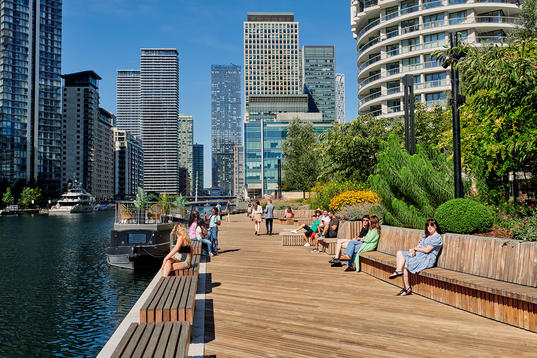Jonathan Ly is Director – Structures at Canary Wharf Group (CWG), one of ConcreteZero’s founding members.
We went on a site visit to discover more about what ConcreteZero member CWG are doing to slash concrete emissions at their Wood Wharf site in London.
First of all, a little bit about concrete.
Concrete is one of the world’s most used materials, second only to water.
By 2050, almost 70% of the world’s population will live in cities, according to UN predictions. This means we will need hundreds of thousands more buildings, roads and bridges – largely made of concrete.
How do we keep building while also reducing concrete emissions? By increasing demand for net zero concrete. And that is where ConcreteZero comes in.
ConcreteZero brings together pioneering businesses to create a market for net zero concrete. Members make the ambitious commitment to buy and use 30% low emission concrete by 2025 and 50% by 2030, setting a clear pathway to using 100% net zero concrete by 2050 at the very latest.
We asked Jonathan Ly seven questions, as concrete accounts for around 7 percent of global carbon emissions.
-
What is special about CWG’s Wood Wharf site?
Wood Wharf is a mixed-use development which adds a new district to our existing estate. It features an array of new developments like residential, a school and sports facility, commercial sites, and retail space. We have all the necessary elements to create a vibrant new district for Canary Wharf, a place where people can live, work and learn.
-
Why has CWG taken such a leadership role on low emission concrete?
We find ourselves in a very privileged position. We control the area, and we’re in charge of projects from concept through to design, construction, and post-delivery building management.
Ensuring our values of sustainability permeate every stage of the process is paramount. Our influence throughout that process is quite significant. By setting that direction and working collaboratively with our supply chain, we can deliver on the goals and targets that we’ve established.
-
Businesses have many compelling reasons for joining ConcreteZero. Could you elaborate on the main reasons behind CWG’s decision to join?
ConcreteZero is a fantastic initiative, one we’re proud to be a founding member of. It serves as an invaluable place for us to engage in knowledge-sharing. The initiative enables a diverse group of organisations to tap into the latest cutting-edge thinking and innovations, and it further amplifies our voice in pushing the agenda around low carbon construction practices.
-
Why do you think it is so difficult to get people to understand why decarbonising concrete matters? How does it work in practice?
Concrete is all around us – it is an abundant and adaptative material. However, the understanding of how to reduce carbon in concrete production is currently limited.
But by collaborating closely with the supply chain, exploring available alternatives, and demonstrating that we both have the demand and remit to build sustainable buildings, we absolutely can capitalise on those initiatives and innovations.
-
What are some of the major challenges to tackling concrete emissions?
The key is to understand, record and track the data. For example, how can we adjust the concrete mix based on external temperatures, to lower carbon emissions? Without us setting the benchmark to understand how much carbon is associated with concrete works, we do not really know what realistic targets to set, and then work towards improving those targets to get to net zero.
Employing a data-centric strategy and fostering effective collaboration with the supply chain are vital for uncovering future opportunities and maximizing the use of collected information to drive progress. Bringing all stakeholders to the table to devise solutions is essential to bringing them to market more quickly.
-
What is CWG doing to ensure they are using renewable electricity as well?
We procure all our electricity from renewable sources and have entered into a Power Purchase Agreement to help fund and construct wind farms in Scotland. This not only secures additional sources of renewable energy for our estate tenants’ electricity supply but also supports our on-site construction activities.
-
What are your priorities in terms of concrete for 2024?
Our priorities around concrete are focused on ensuring that we keep the momentum going and improve on the achievements from our case study projects for ConcreteZero. Our goals are to improve our targets, leverage innovations, and deepen supply chain collaboration to bring more ideas to the table. We prioritise sharing that knowledge with the wider industry, as well as showing that sustainable concrete can be done. We do this by demonstrating tangible improvements and through participating in conferences like the WTW’s Low Carbon Concrete Event with the Low Carbon Concrete Group, which is attended by insurers and underwriters and similar affiliated events throughout the year. We actively support and collaborate with new green tech companies to implement the latest innovations for decarbonising construction materials.
We also will continue to advance our circularity practices, like reusing recycled crushed concrete aggregate from demolished concrete recovered from our sites on all new projects. We‘ve collected extensive data from our case study projects and collaborated with Cambridge University in assessing it to identify trends and opportunities to further reduce embodied carbon in our projects. We are excited at the prospect of partnering with our key supply chain to incorporate AI and machine learning into the process to help fast track our journey to net zero.
